F11C - Unit 14: Advanced Management Accounting - AMA1 Report
VerifiedAdded on 2021/03/25
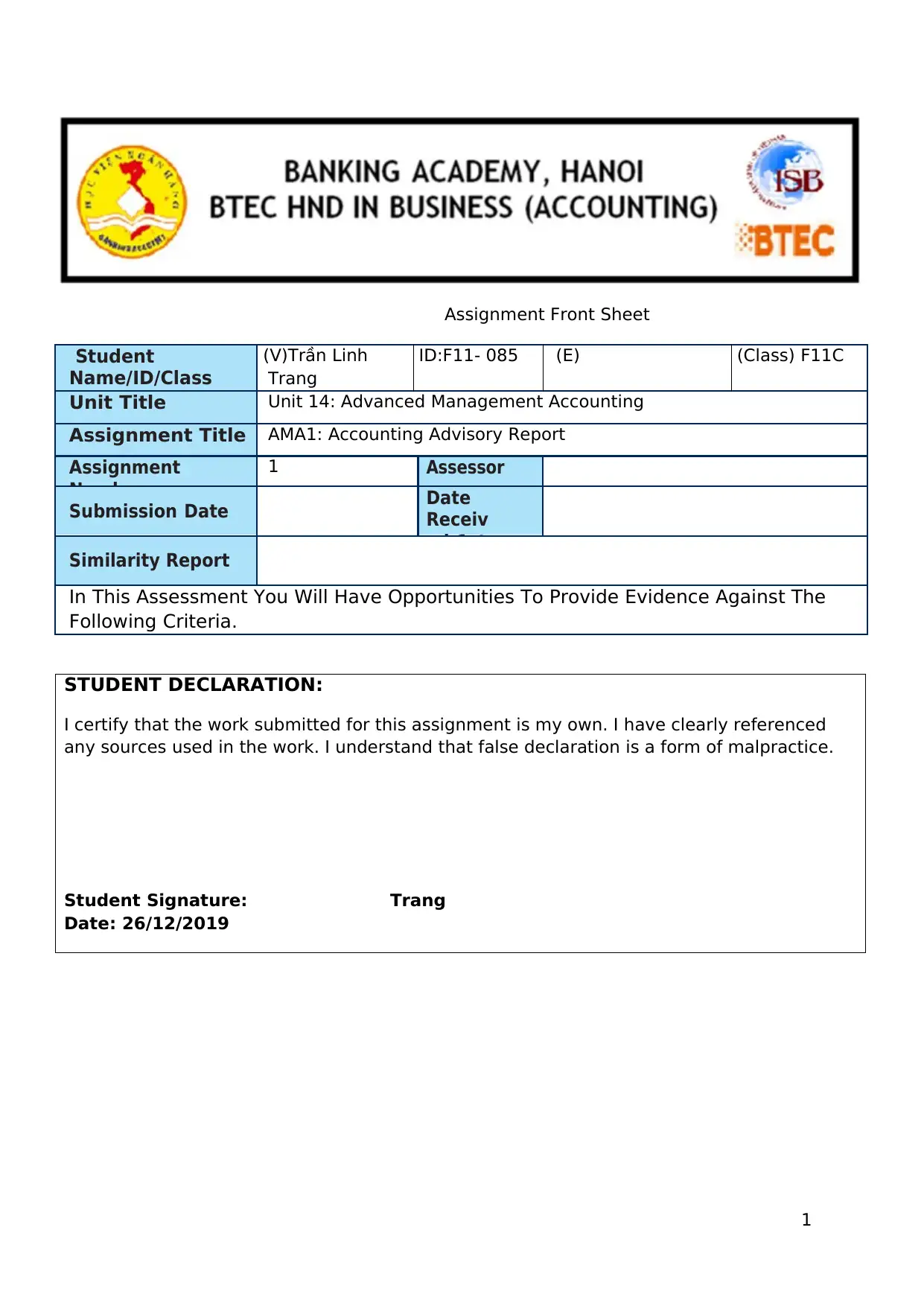
Student
Name/ID/Class
(V)Trần Linh
Trang
ID:F11- 085 (E) (Class) F11C
Unit Title Unit 14: Advanced Management Accounting
Assignment Title AMA1: Accounting Advisory Report
Assignment
Number
1 Assessor
Submission Date Date
Receiv
ed 1st
Similarity Report
In This Assessment You Will Have Opportunities To Provide Evidence Against The
Following Criteria.
Indicate The Page Numbers Where The Evidence Can Be Found
STUDENT DECLARATION:
I certify that the work submitted for this assignment is my own. I have clearly referenced
any sources used in the work. I understand that false declaration is a form of malpractice.
Student Signature: Trang
Date: 26/12/2019
1
Paraphrase This Document
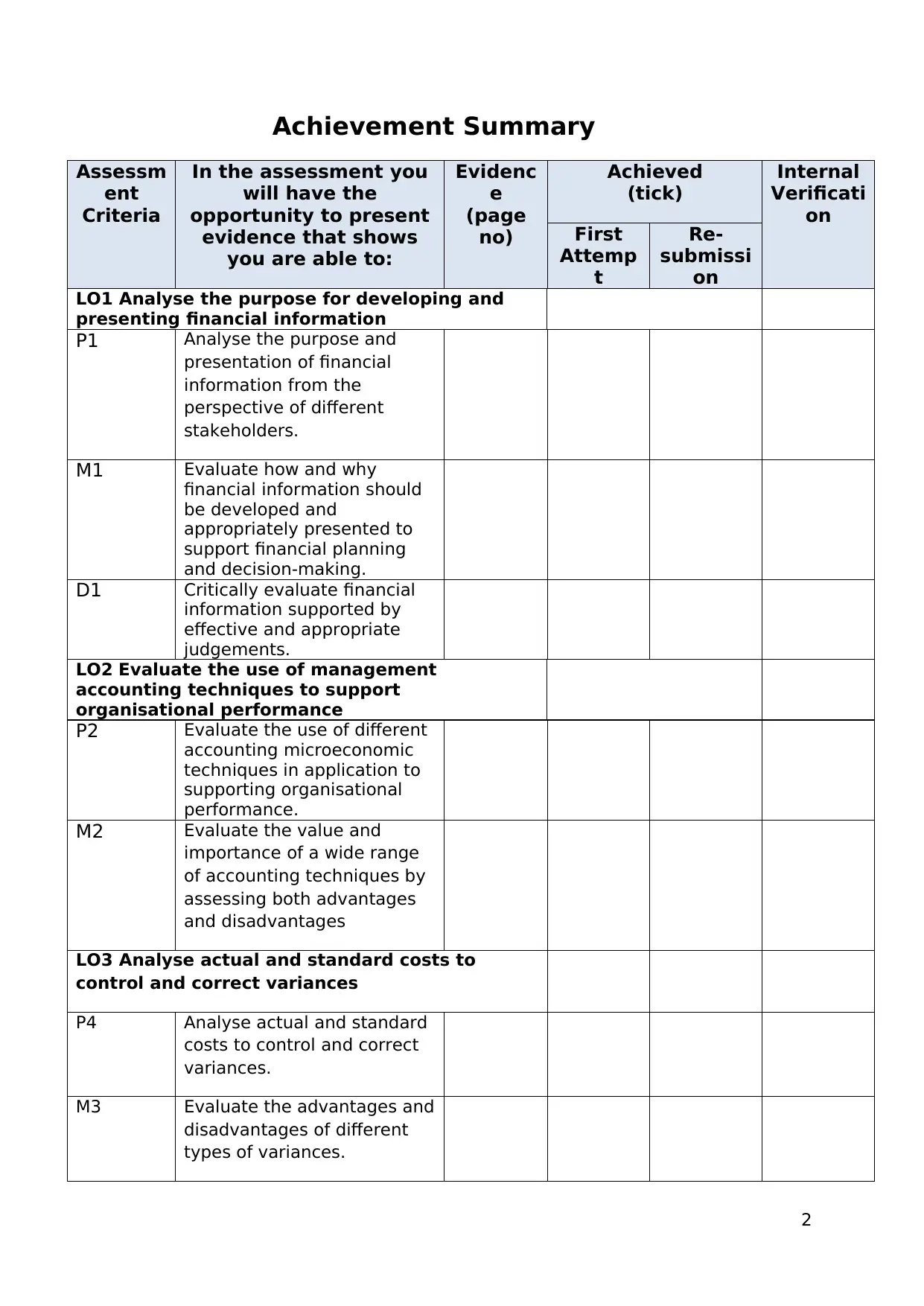
Assessm
ent
Criteria
In the assessment you
will have the
opportunity to present
evidence that shows
you are able to:
Evidenc
e
(page
no)
Achieved
(tick)
Internal
Verificati
on
First
Attemp
t
Re-
submissi
on
LO1 Analyse the purpose for developing and
presenting financial information
P1 Analyse the purpose and
presentation of financial
information from the
perspective of different
stakeholders.
M1 Evaluate how and why
financial information should
be developed and
appropriately presented to
support financial planning
and decision-making.
D1 Critically evaluate financial
information supported by
effective and appropriate
judgements.
LO2 Evaluate the use of management
accounting techniques to support
organisational performance
P2 Evaluate the use of different
accounting microeconomic
techniques in application to
supporting organisational
performance.
M2 Evaluate the value and
importance of a wide range
of accounting techniques by
assessing both advantages
and disadvantages
LO3 Analyse actual and standard costs to
control and correct variances
P4 Analyse actual and standard
costs to control and correct
variances.
M3 Evaluate the advantages and
disadvantages of different
types of variances.
2
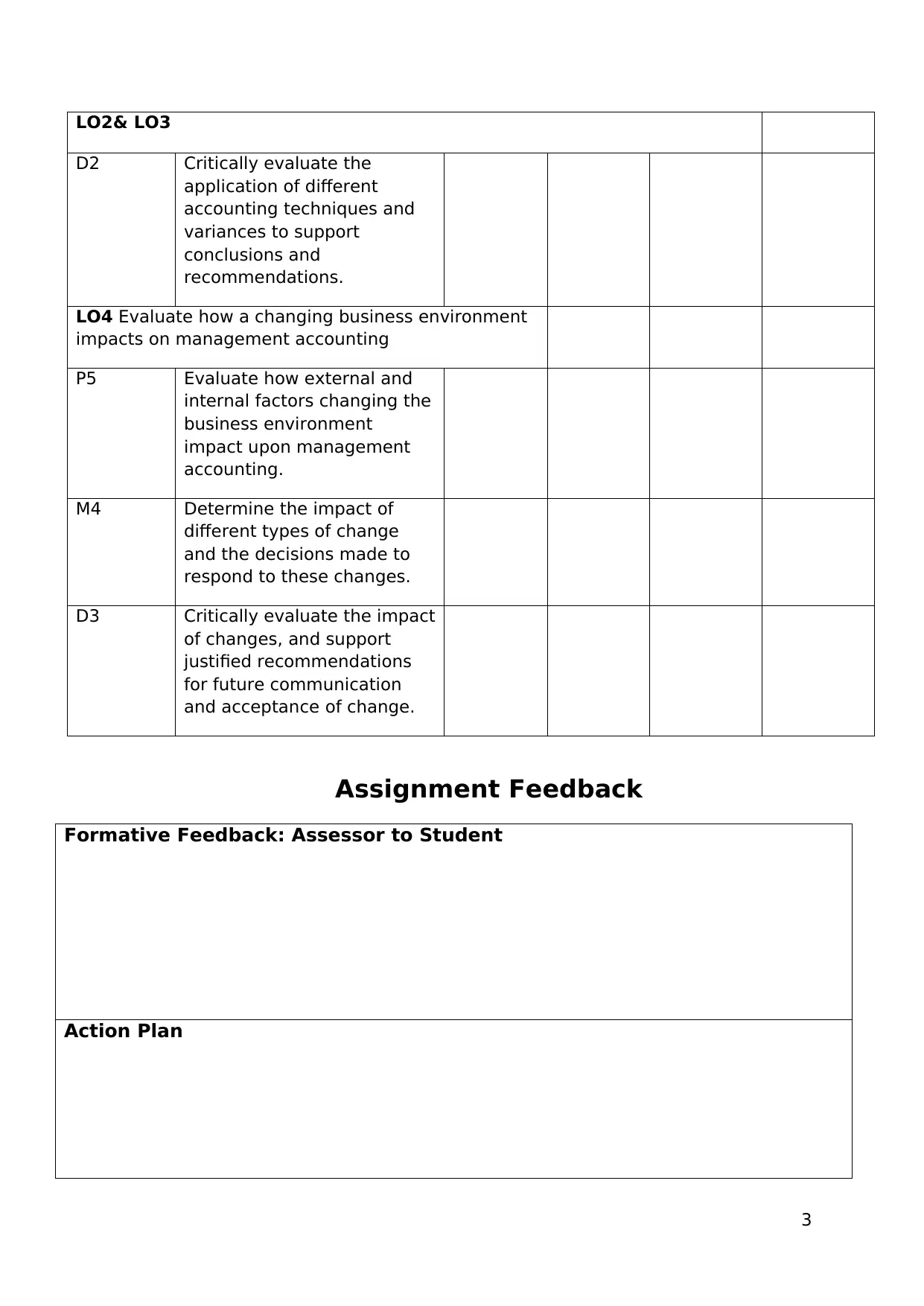
D2 Critically evaluate the
application of different
accounting techniques and
variances to support
conclusions and
recommendations.
LO4 Evaluate how a changing business environment
impacts on management accounting
P5 Evaluate how external and
internal factors changing the
business environment
impact upon management
accounting.
M4 Determine the impact of
different types of change
and the decisions made to
respond to these changes.
D3 Critically evaluate the impact
of changes, and support
justified recommendations
for future communication
and acceptance of change.
Assignment Feedback
Formative Feedback: Assessor to Student
Action Plan
3
⊘ This is a preview!⊘
Do you want full access?
Subscribe today to unlock all pages.

Trusted by 1+ million students worldwide
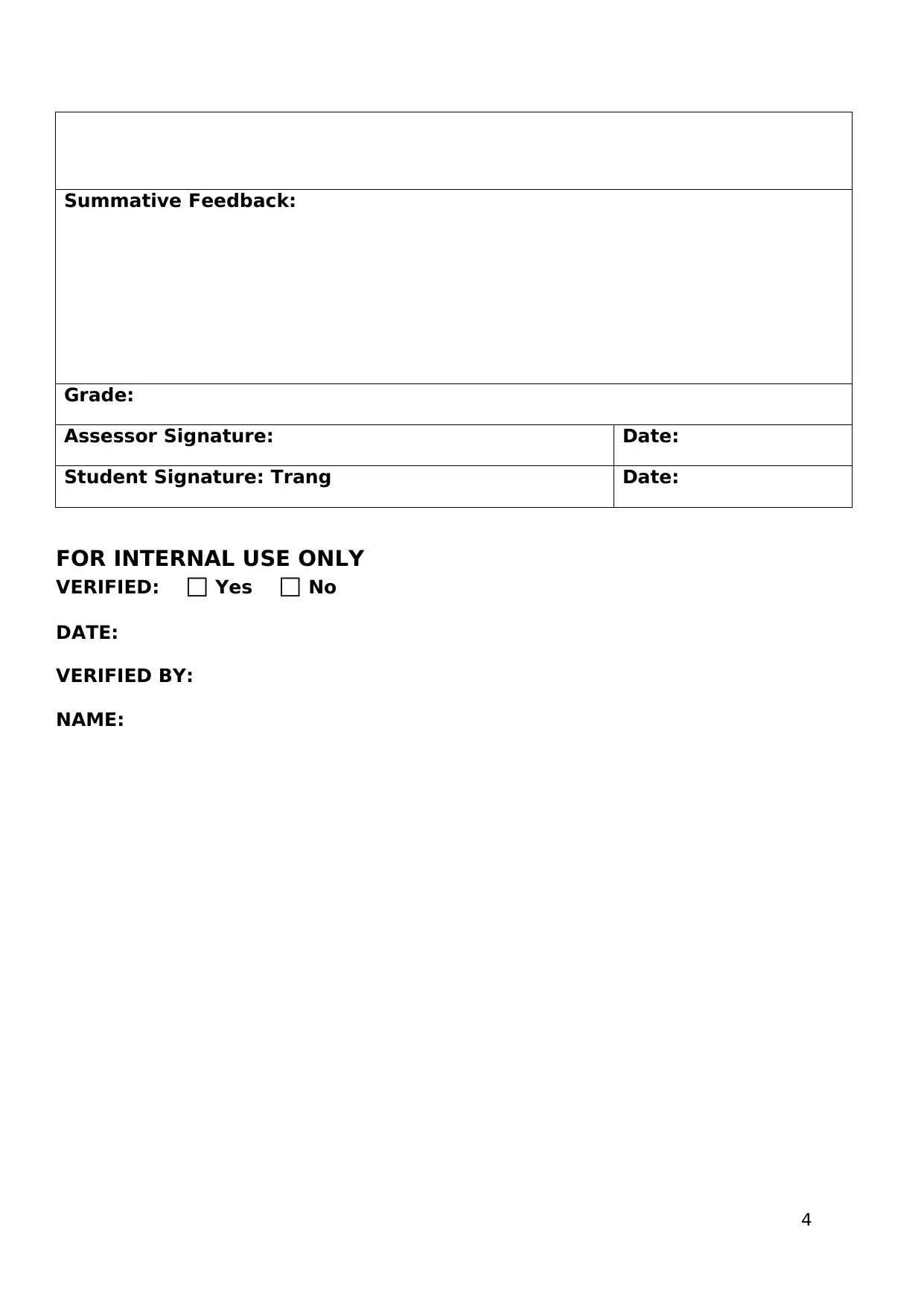
Grade:
Assessor Signature: Date:
Student Signature: Trang Date:
FOR INTERNAL USE ONLY
VERIFIED: □ Yes □ No
DATE:
VERIFIED BY:
NAME:
4
Paraphrase This Document
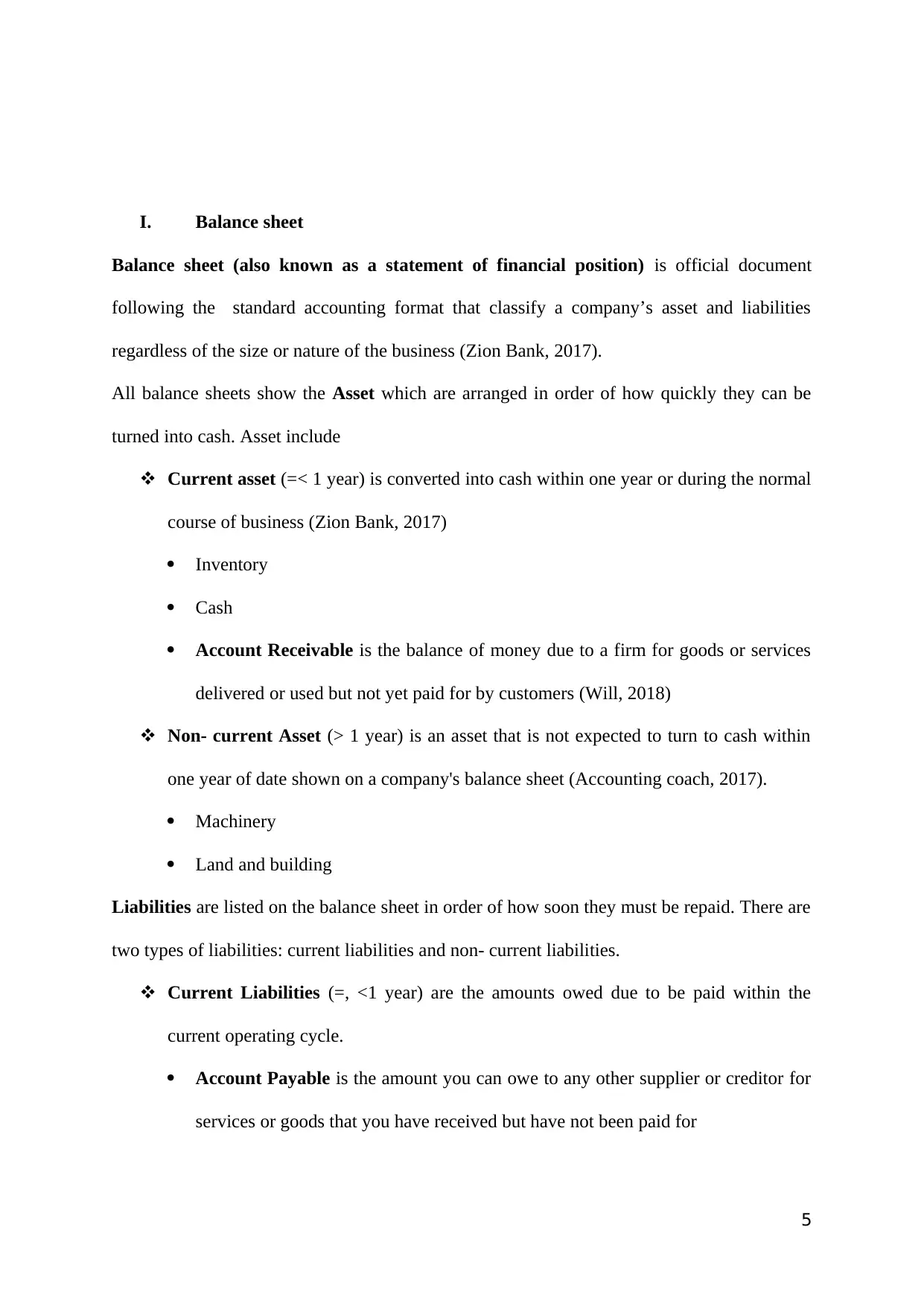
Balance sheet (also known as a statement of financial position) is official document
following the standard accounting format that classify a company’s asset and liabilities
regardless of the size or nature of the business (Zion Bank, 2017).
All balance sheets show the Asset which are arranged in order of how quickly they can be
turned into cash. Asset include
Current asset (=< 1 year) is converted into cash within one year or during the normal
course of business (Zion Bank, 2017)
Inventory
Cash
Account Receivable is the balance of money due to a firm for goods or services
delivered or used but not yet paid for by customers (Will, 2018)
Non- current Asset (> 1 year) is an asset that is not expected to turn to cash within
one year of date shown on a company's balance sheet (Accounting coach, 2017).
Machinery
Land and building
Liabilities are listed on the balance sheet in order of how soon they must be repaid. There are
two types of liabilities: current liabilities and non- current liabilities.
Current Liabilities (=, <1 year) are the amounts owed due to be paid within the
current operating cycle.
Account Payable is the amount you can owe to any other supplier or creditor for
services or goods that you have received but have not been paid for
5

more than one year from the date of the balance sheet
Loan
Equity refers to the net financial amount the owner of the company has invested in the
business, including all retained earnings (Elise, 2019)
Share Capital is the money a company raises by issuing common or preferred
stock
Retained Earnings is the amount of net income left over for the business after it
has paid out dividends to its shareholders. \
The benefits for user
Investor
In balance sheet, Investor wants to know about the total asset of the company such as: cash,
equipment, land, building, inventories, investment, etc because they can know how much
money the company owns and its cash stockpile is big enough to pay money borrowed back
to bankers. Additionally, the investors are able to see the ability in making good on its short-
term financial obligations.
Moreover, investors see the shareholder’s equity is the money which goes to the company,
its owner or shareholder because it represents the amount that will be returned to the
shareholders if all the assets are liquidated and all the debts of the company have been paid
off. Shareholder’s equity= Total asset- liabilities, higher equity means more money for
shareholders which is company’s net income, net worth and overall value.
Creditor
6
⊘ This is a preview!⊘
Do you want full access?
Subscribe today to unlock all pages.

Trusted by 1+ million students worldwide
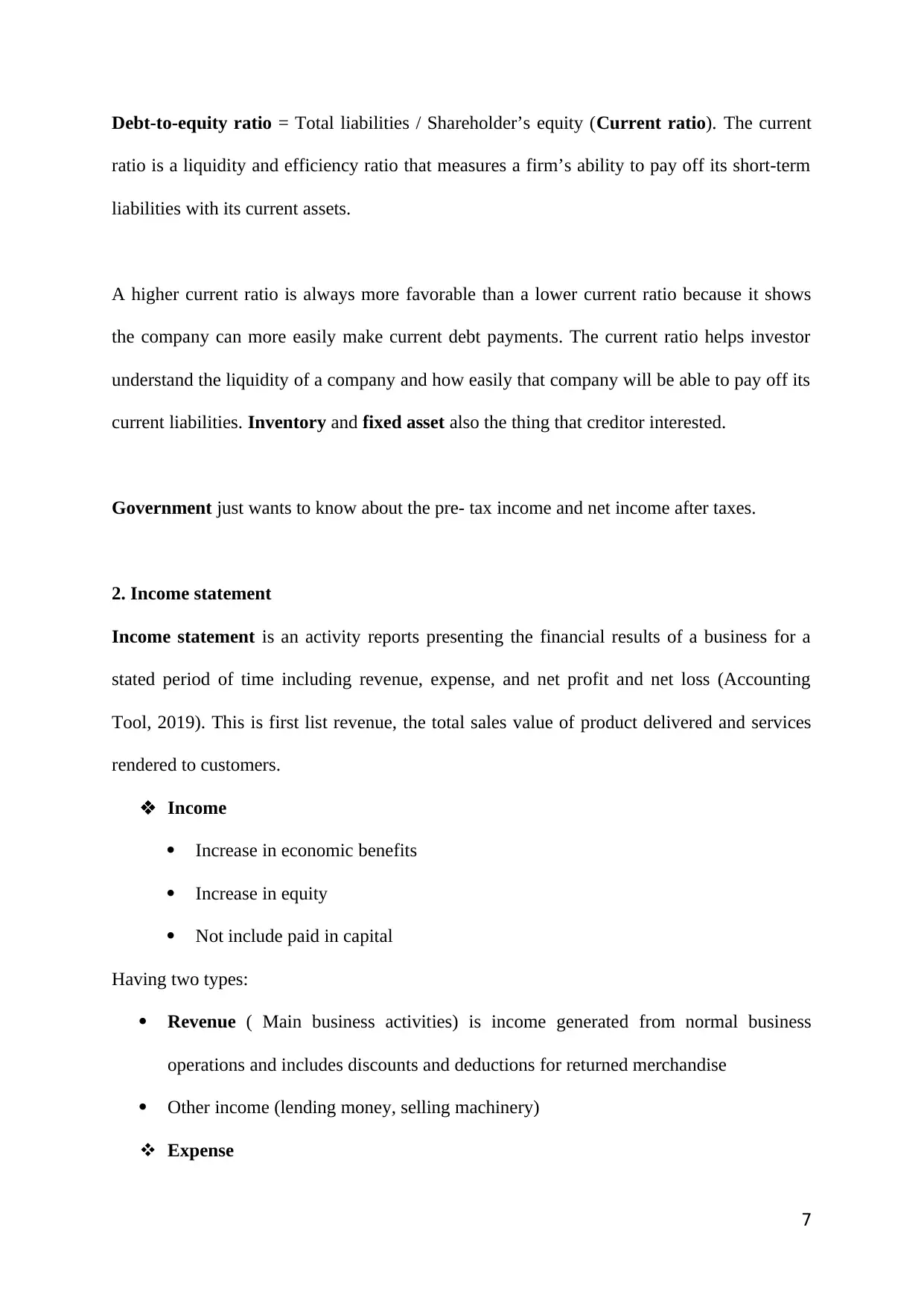
ratio is a liquidity and efficiency ratio that measures a firm’s ability to pay off its short-term
liabilities with its current assets.
A higher current ratio is always more favorable than a lower current ratio because it shows
the company can more easily make current debt payments. The current ratio helps investor
understand the liquidity of a company and how easily that company will be able to pay off its
current liabilities. Inventory and fixed asset also the thing that creditor interested.
Government just wants to know about the pre- tax income and net income after taxes.
2. Income statement
Income statement is an activity reports presenting the financial results of a business for a
stated period of time including revenue, expense, and net profit and net loss (Accounting
Tool, 2019). This is first list revenue, the total sales value of product delivered and services
rendered to customers.
Income
Increase in economic benefits
Increase in equity
Not include paid in capital
Having two types:
Revenue ( Main business activities) is income generated from normal business
operations and includes discounts and deductions for returned merchandise
Other income (lending money, selling machinery)
Expense
7
Paraphrase This Document
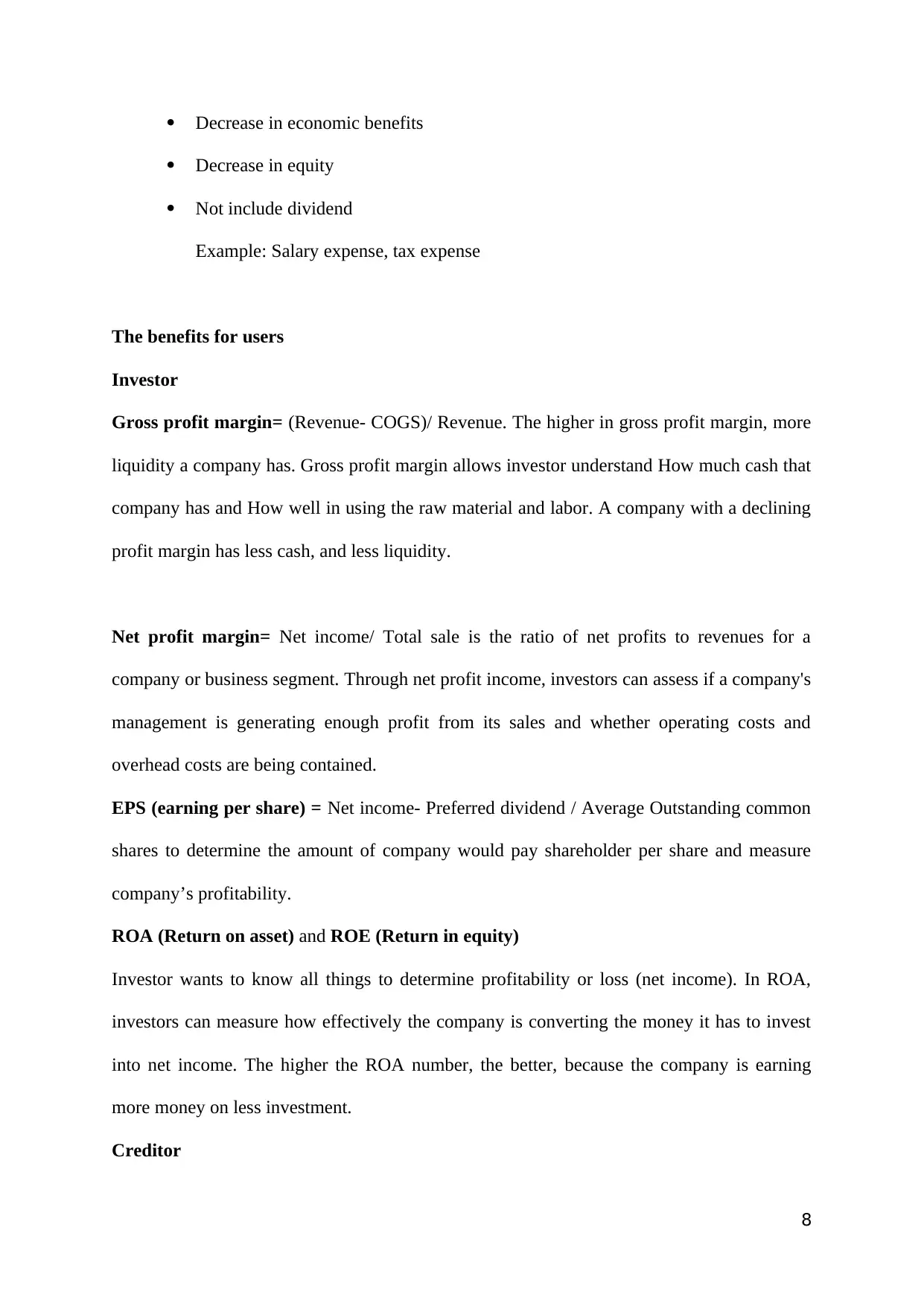
Decrease in equity
Not include dividend
Example: Salary expense, tax expense
The benefits for users
Investor
Gross profit margin= (Revenue- COGS)/ Revenue. The higher in gross profit margin, more
liquidity a company has. Gross profit margin allows investor understand How much cash that
company has and How well in using the raw material and labor. A company with a declining
profit margin has less cash, and less liquidity.
Net profit margin= Net income/ Total sale is the ratio of net profits to revenues for a
company or business segment. Through net profit income, investors can assess if a company's
management is generating enough profit from its sales and whether operating costs and
overhead costs are being contained.
EPS (earning per share) = Net income- Preferred dividend / Average Outstanding common
shares to determine the amount of company would pay shareholder per share and measure
company’s profitability.
ROA (Return on asset) and ROE (Return in equity)
Investor wants to know all things to determine profitability or loss (net income). In ROA,
investors can measure how effectively the company is converting the money it has to invest
into net income. The higher the ROA number, the better, because the company is earning
more money on less investment.
Creditor
8
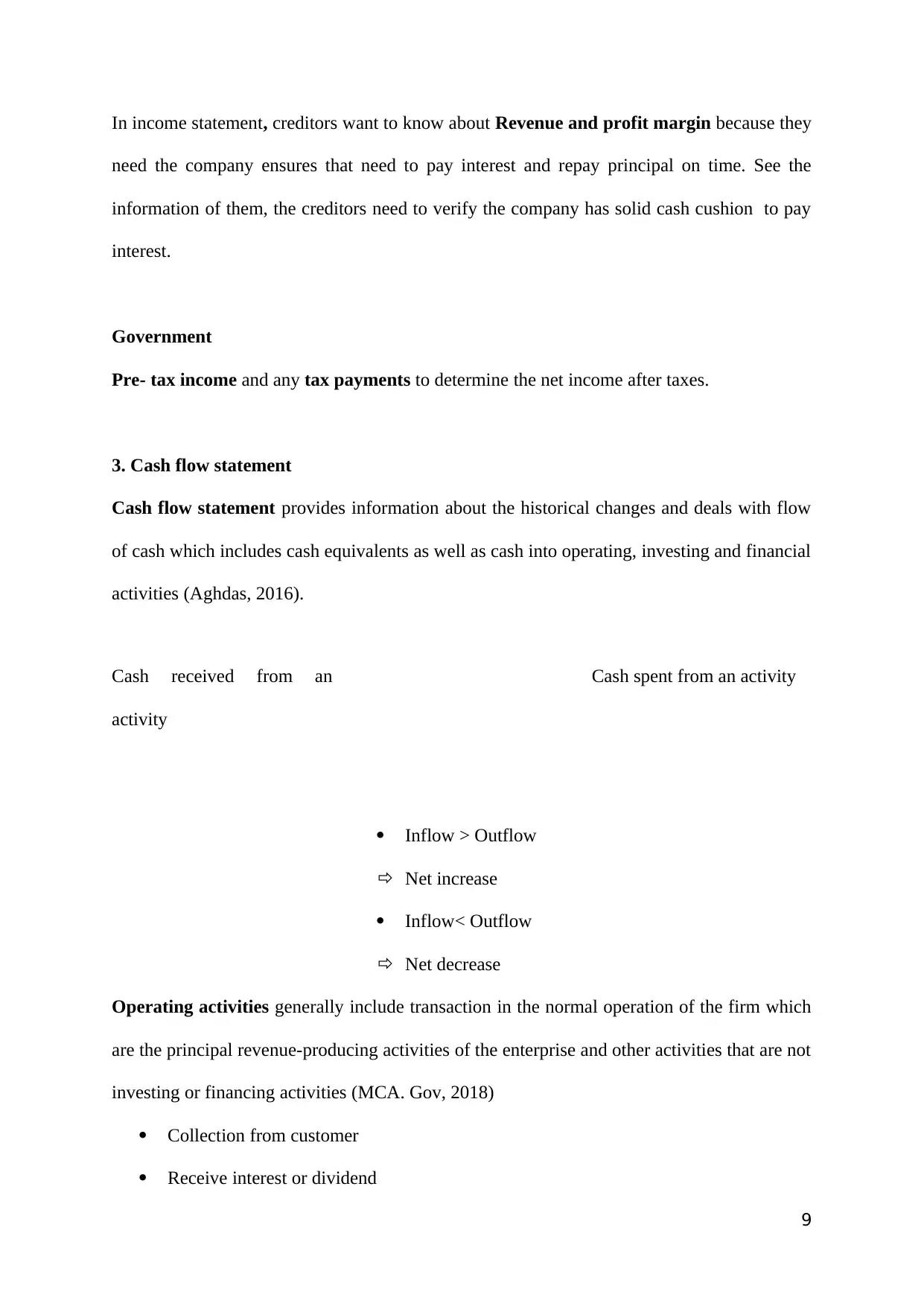
need the company ensures that need to pay interest and repay principal on time. See the
information of them, the creditors need to verify the company has solid cash cushion to pay
interest.
Government
Pre- tax income and any tax payments to determine the net income after taxes.
3. Cash flow statement
Cash flow statement provides information about the historical changes and deals with flow
of cash which includes cash equivalents as well as cash into operating, investing and financial
activities (Aghdas, 2016).
Cash received from an
activity
Cash spent from an activity
Inflow > Outflow
Net increase
Inflow< Outflow
Net decrease
Operating activities generally include transaction in the normal operation of the firm which
are the principal revenue-producing activities of the enterprise and other activities that are not
investing or financing activities (MCA. Gov, 2018)
Collection from customer
Receive interest or dividend
9
⊘ This is a preview!⊘
Do you want full access?
Subscribe today to unlock all pages.

Trusted by 1+ million students worldwide
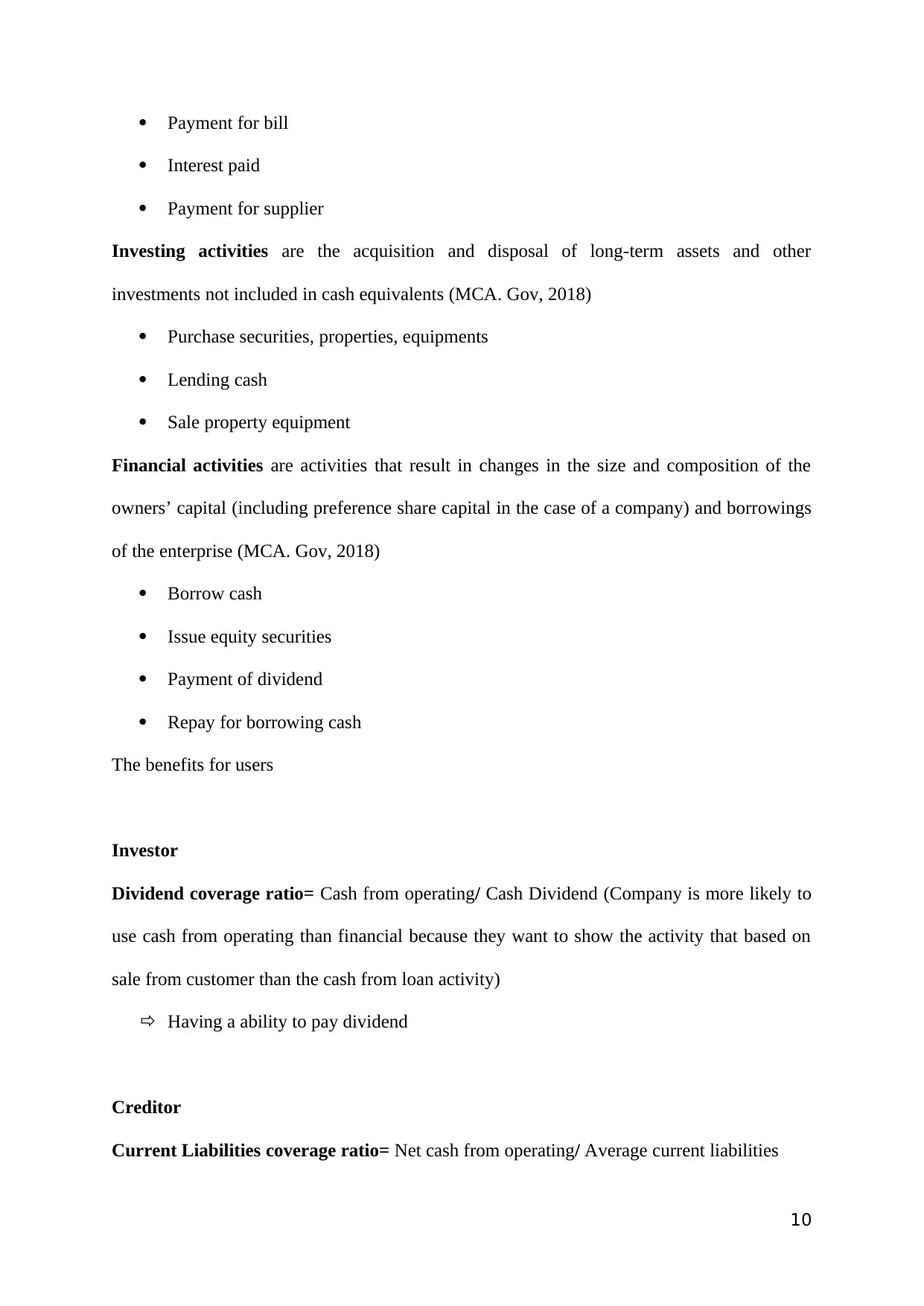
Interest paid
Payment for supplier
Investing activities are the acquisition and disposal of long-term assets and other
investments not included in cash equivalents (MCA. Gov, 2018)
Purchase securities, properties, equipments
Lending cash
Sale property equipment
Financial activities are activities that result in changes in the size and composition of the
owners’ capital (including preference share capital in the case of a company) and borrowings
of the enterprise (MCA. Gov, 2018)
Borrow cash
Issue equity securities
Payment of dividend
Repay for borrowing cash
The benefits for users
Investor
Dividend coverage ratio= Cash from operating/ Cash Dividend (Company is more likely to
use cash from operating than financial because they want to show the activity that based on
sale from customer than the cash from loan activity)
Having a ability to pay dividend
Creditor
Current Liabilities coverage ratio= Net cash from operating/ Average current liabilities
10
Paraphrase This Document
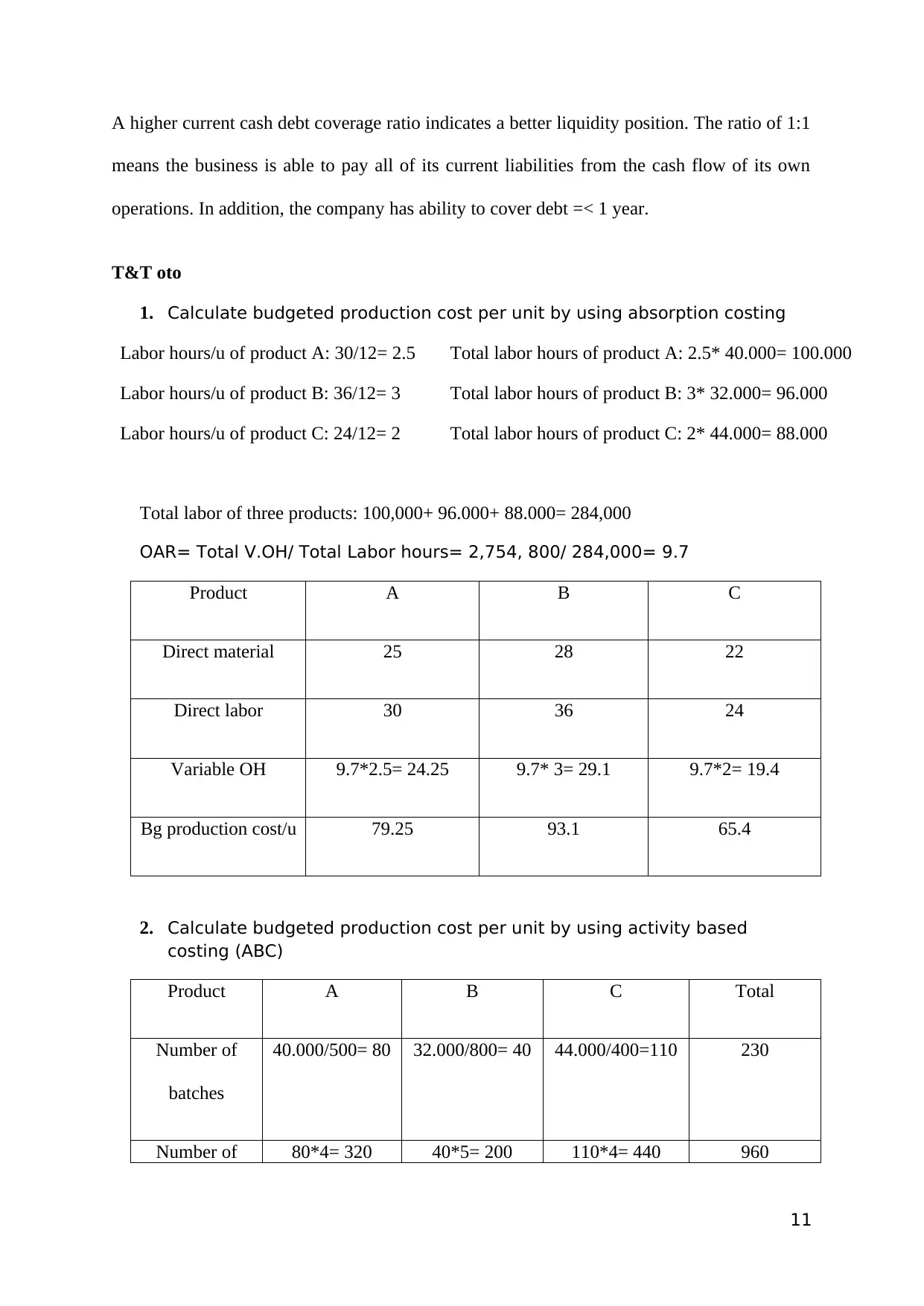
means the business is able to pay all of its current liabilities from the cash flow of its own
operations. In addition, the company has ability to cover debt =< 1 year.
T&T oto
1. Calculate budgeted production cost per unit by using absorption costing
Labor hours/u of product A: 30/12= 2.5 Total labor hours of product A: 2.5* 40.000= 100.000
Labor hours/u of product B: 36/12= 3 Total labor hours of product B: 3* 32.000= 96.000
Labor hours/u of product C: 24/12= 2 Total labor hours of product C: 2* 44.000= 88.000
Total labor of three products: 100,000+ 96.000+ 88.000= 284,000
OAR= Total V.OH/ Total Labor hours= 2,754, 800/ 284,000= 9.7
Product A B C
Direct material 25 28 22
Direct labor 30 36 24
Variable OH 9.7*2.5= 24.25 9.7* 3= 29.1 9.7*2= 19.4
Bg production cost/u 79.25 93.1 65.4
2. Calculate budgeted production cost per unit by using activity based
costing (ABC)
Product A B C Total
Number of
batches
40.000/500= 80 32.000/800= 40 44.000/400=110 230
Number of 80*4= 320 40*5= 200 110*4= 440 960
11
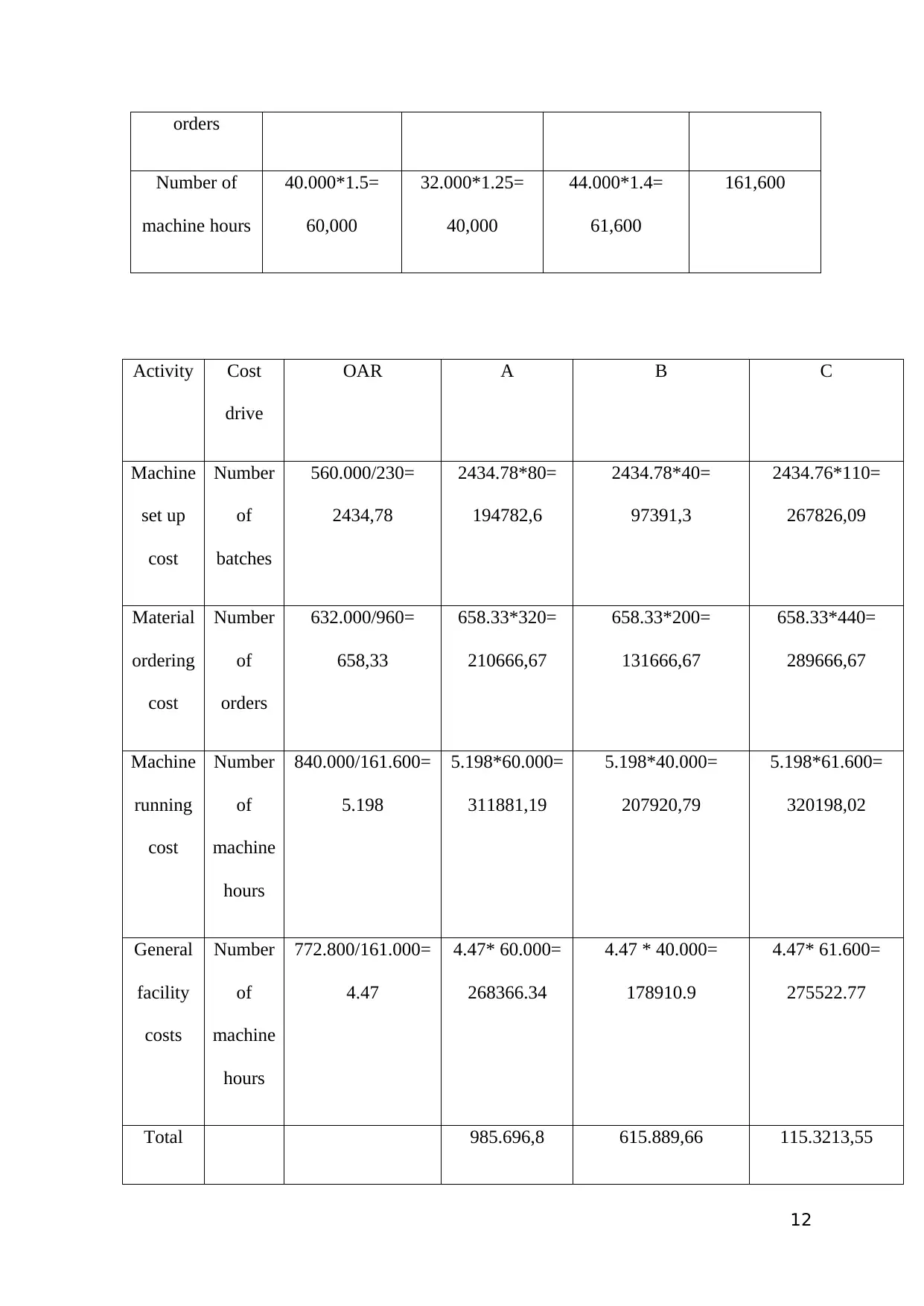
Number of
machine hours
40.000*1.5=
60,000
32.000*1.25=
40,000
44.000*1.4=
61,600
161,600
Activity Cost
drive
OAR A B C
Machine
set up
cost
Number
of
batches
560.000/230=
2434,78
2434.78*80=
194782,6
2434.78*40=
97391,3
2434.76*110=
267826,09
Material
ordering
cost
Number
of
orders
632.000/960=
658,33
658.33*320=
210666,67
658.33*200=
131666,67
658.33*440=
289666,67
Machine
running
cost
Number
of
machine
hours
840.000/161.600=
5.198
5.198*60.000=
311881,19
5.198*40.000=
207920,79
5.198*61.600=
320198,02
General
facility
costs
Number
of
machine
hours
772.800/161.000=
4.47
4.47* 60.000=
268366.34
4.47 * 40.000=
178910.9
4.47* 61.600=
275522.77
Total 985.696,8 615.889,66 115.3213,55
12
⊘ This is a preview!⊘
Do you want full access?
Subscribe today to unlock all pages.

Trusted by 1+ million students worldwide
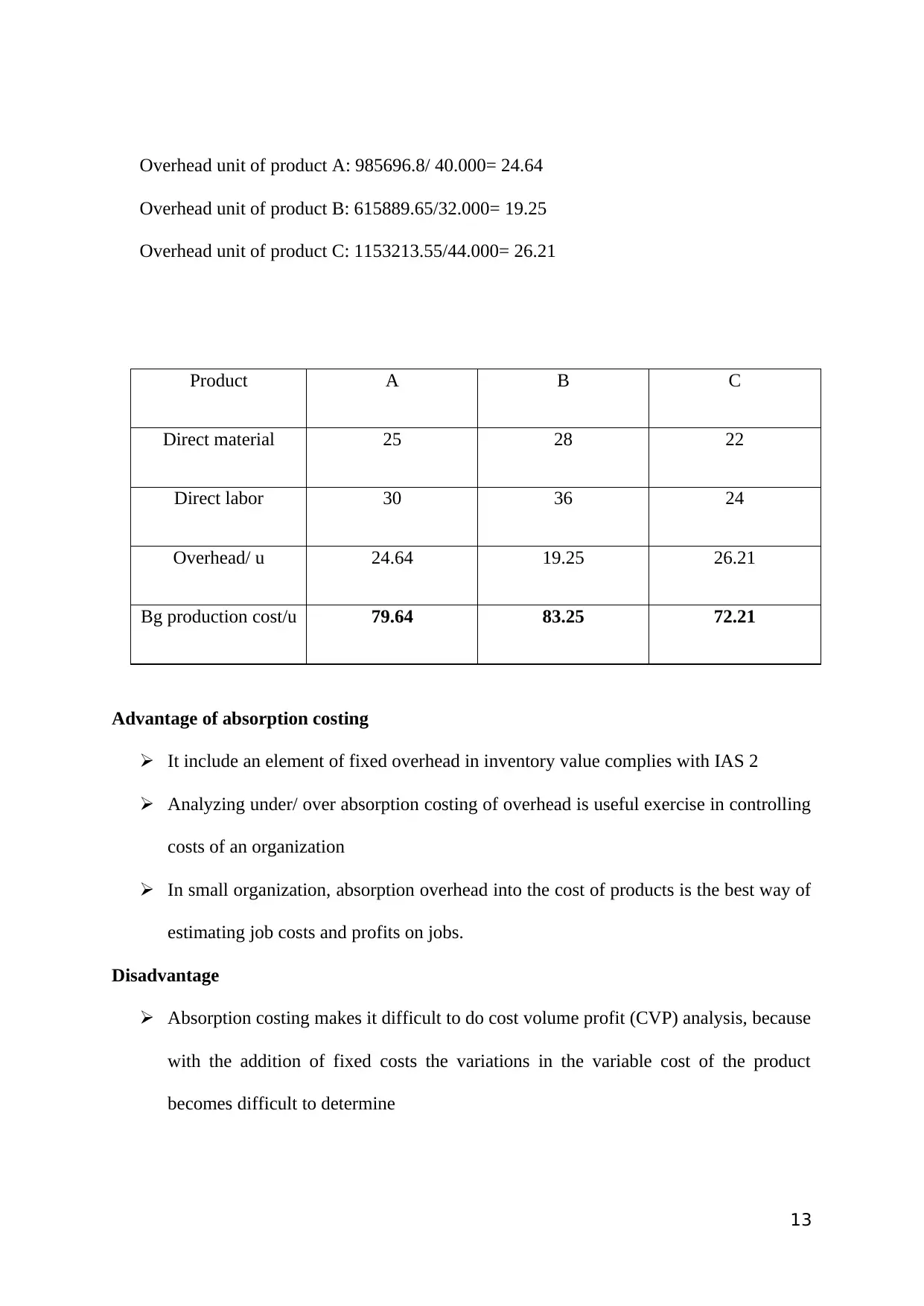
Overhead unit of product B: 615889.65/32.000= 19.25
Overhead unit of product C: 1153213.55/44.000= 26.21
Product A B C
Direct material 25 28 22
Direct labor 30 36 24
Overhead/ u 24.64 19.25 26.21
Bg production cost/u 79.64 83.25 72.21
Advantage of absorption costing
It include an element of fixed overhead in inventory value complies with IAS 2
Analyzing under/ over absorption costing of overhead is useful exercise in controlling
costs of an organization
In small organization, absorption overhead into the cost of products is the best way of
estimating job costs and profits on jobs.
Disadvantage
Absorption costing makes it difficult to do cost volume profit (CVP) analysis, because
with the addition of fixed costs the variations in the variable cost of the product
becomes difficult to determine
13
Paraphrase This Document
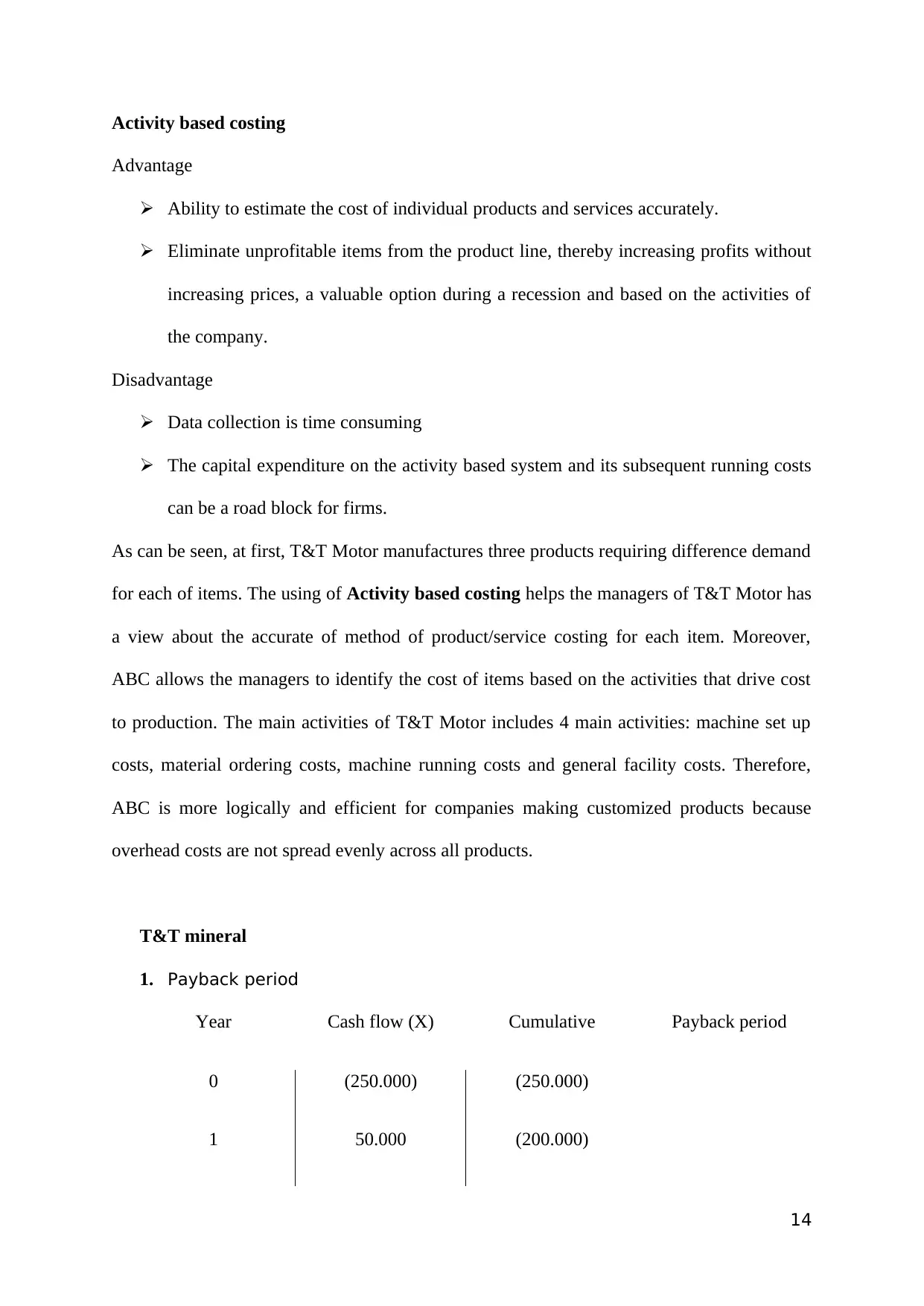
Advantage
Ability to estimate the cost of individual products and services accurately.
Eliminate unprofitable items from the product line, thereby increasing profits without
increasing prices, a valuable option during a recession and based on the activities of
the company.
Disadvantage
Data collection is time consuming
The capital expenditure on the activity based system and its subsequent running costs
can be a road block for firms.
As can be seen, at first, T&T Motor manufactures three products requiring difference demand
for each of items. The using of Activity based costing helps the managers of T&T Motor has
a view about the accurate of method of product/service costing for each item. Moreover,
ABC allows the managers to identify the cost of items based on the activities that drive cost
to production. The main activities of T&T Motor includes 4 main activities: machine set up
costs, material ordering costs, machine running costs and general facility costs. Therefore,
ABC is more logically and efficient for companies making customized products because
overhead costs are not spread evenly across all products.
T&T mineral
1. Payback period
Year Cash flow (X) Cumulative Payback period
0 (250.000) (250.000)
1 50.000 (200.000)
14
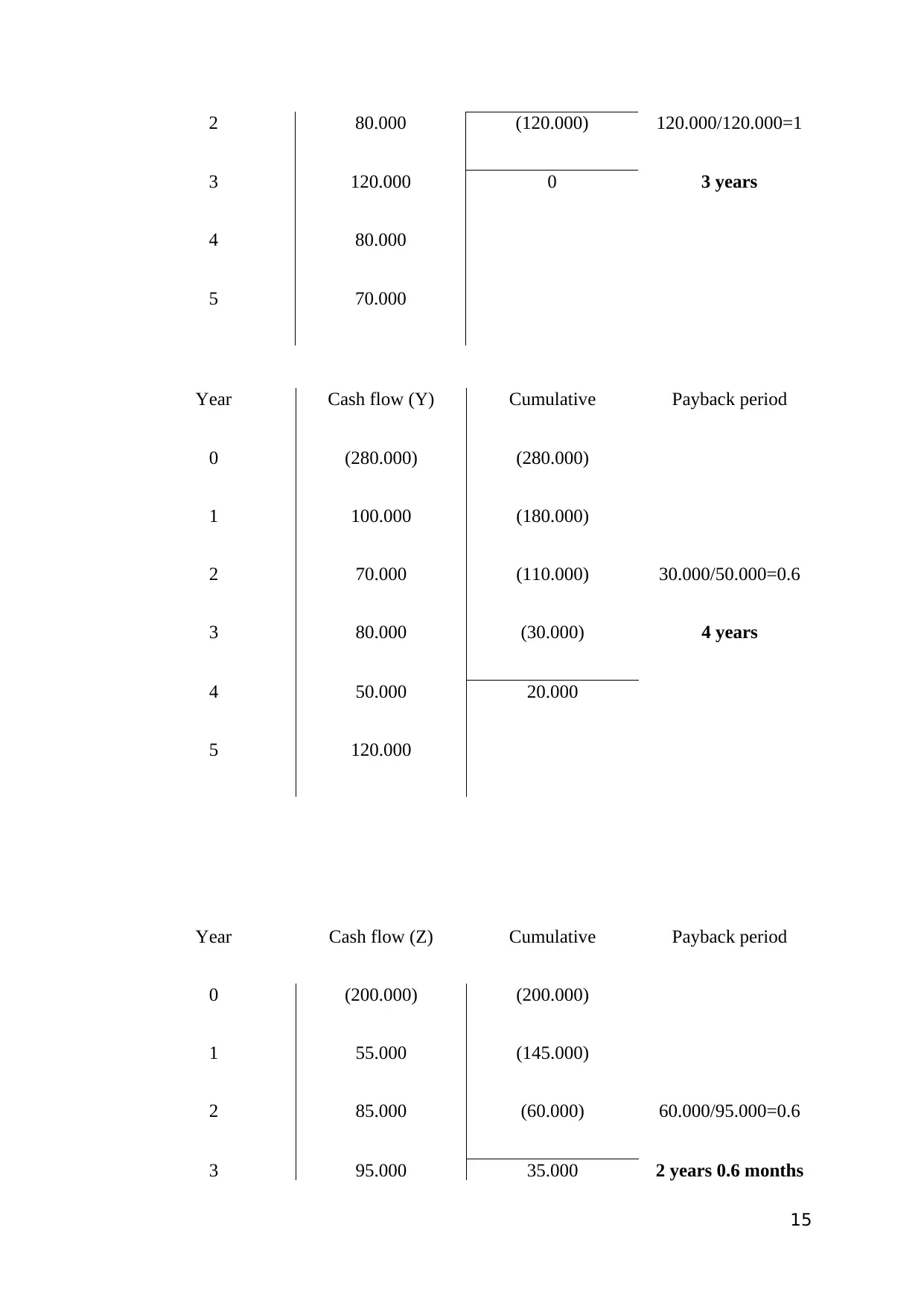
3 120.000 0 3 years
4 80.000
5 70.000
Year Cash flow (Y) Cumulative Payback period
0 (280.000) (280.000)
1 100.000 (180.000)
2 70.000 (110.000) 30.000/50.000=0.6
3 80.000 (30.000) 4 years
4 50.000 20.000
5 120.000
Year Cash flow (Z) Cumulative Payback period
0 (200.000) (200.000)
1 55.000 (145.000)
2 85.000 (60.000) 60.000/95.000=0.6
3 95.000 35.000 2 years 0.6 months
15
⊘ This is a preview!⊘
Do you want full access?
Subscribe today to unlock all pages.

Trusted by 1+ million students worldwide
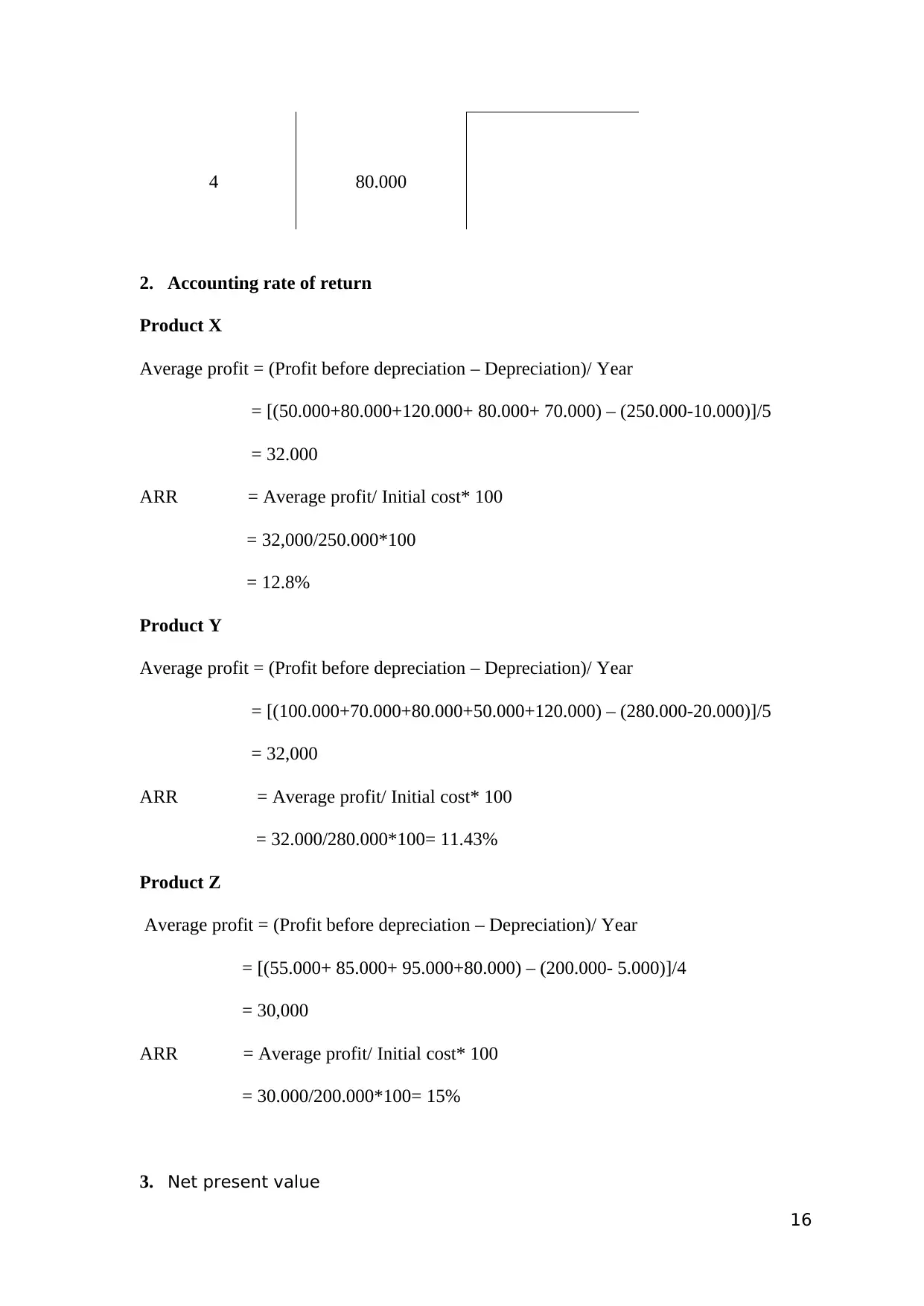
2. Accounting rate of return
Product X
Average profit = (Profit before depreciation – Depreciation)/ Year
= [(50.000+80.000+120.000+ 80.000+ 70.000) – (250.000-10.000)]/5
= 32.000
ARR = Average profit/ Initial cost* 100
= 32,000/250.000*100
= 12.8%
Product Y
Average profit = (Profit before depreciation – Depreciation)/ Year
= [(100.000+70.000+80.000+50.000+120.000) – (280.000-20.000)]/5
= 32,000
ARR = Average profit/ Initial cost* 100
= 32.000/280.000*100= 11.43%
Product Z
Average profit = (Profit before depreciation – Depreciation)/ Year
= [(55.000+ 85.000+ 95.000+80.000) – (200.000- 5.000)]/4
= 30,000
ARR = Average profit/ Initial cost* 100
= 30.000/200.000*100= 15%
3. Net present value
16
Paraphrase This Document
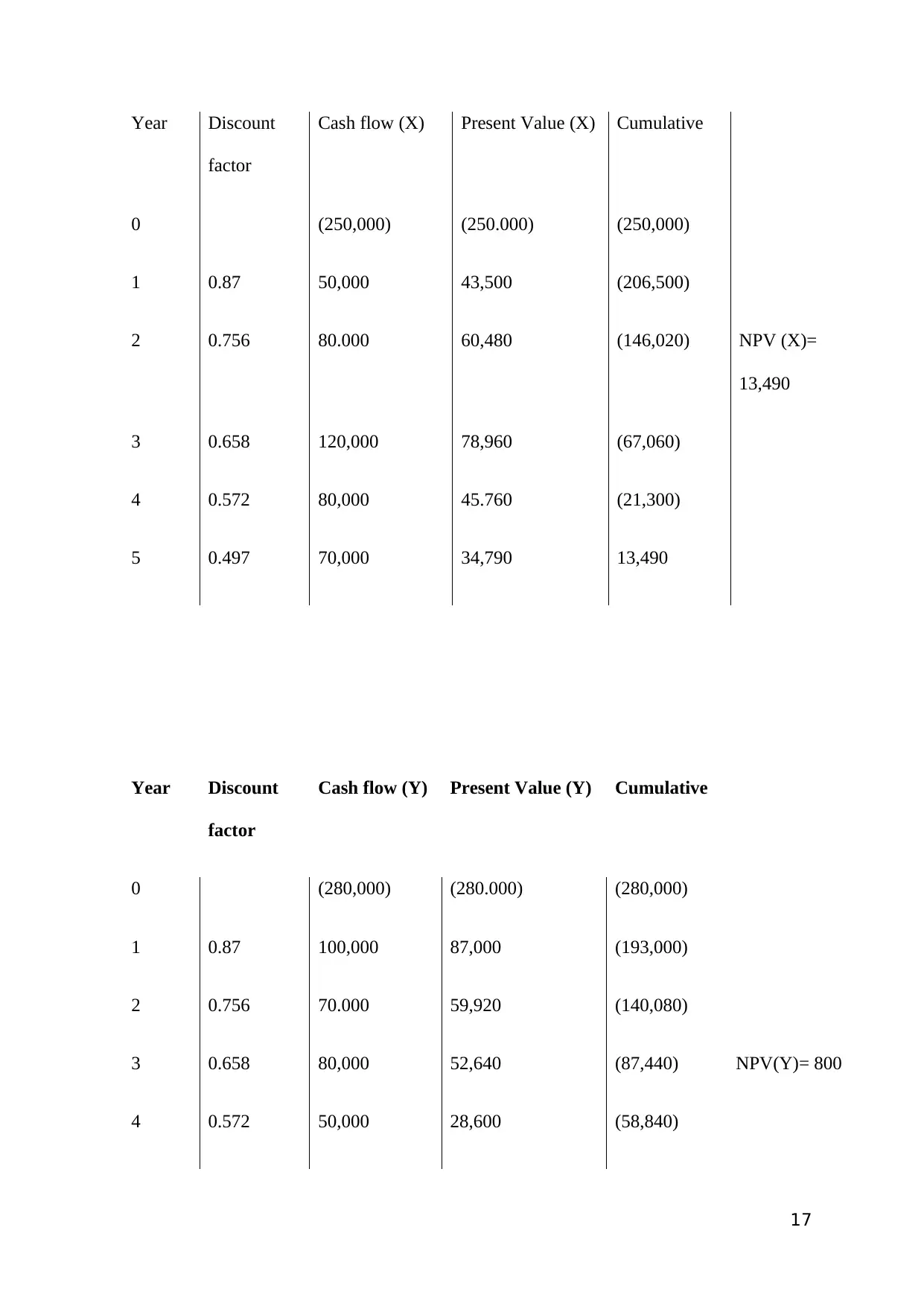
factor
Cash flow (X) Present Value (X) Cumulative
0 (250,000) (250.000) (250,000)
1 0.87 50,000 43,500 (206,500)
2 0.756 80.000 60,480 (146,020) NPV (X)=
13,490
3 0.658 120,000 78,960 (67,060)
4 0.572 80,000 45.760 (21,300)
5 0.497 70,000 34,790 13,490
Year Discount
factor
Cash flow (Y) Present Value (Y) Cumulative
0 (280,000) (280.000) (280,000)
1 0.87 100,000 87,000 (193,000)
2 0.756 70.000 59,920 (140,080)
3 0.658 80,000 52,640 (87,440) NPV(Y)= 800
4 0.572 50,000 28,600 (58,840)
17
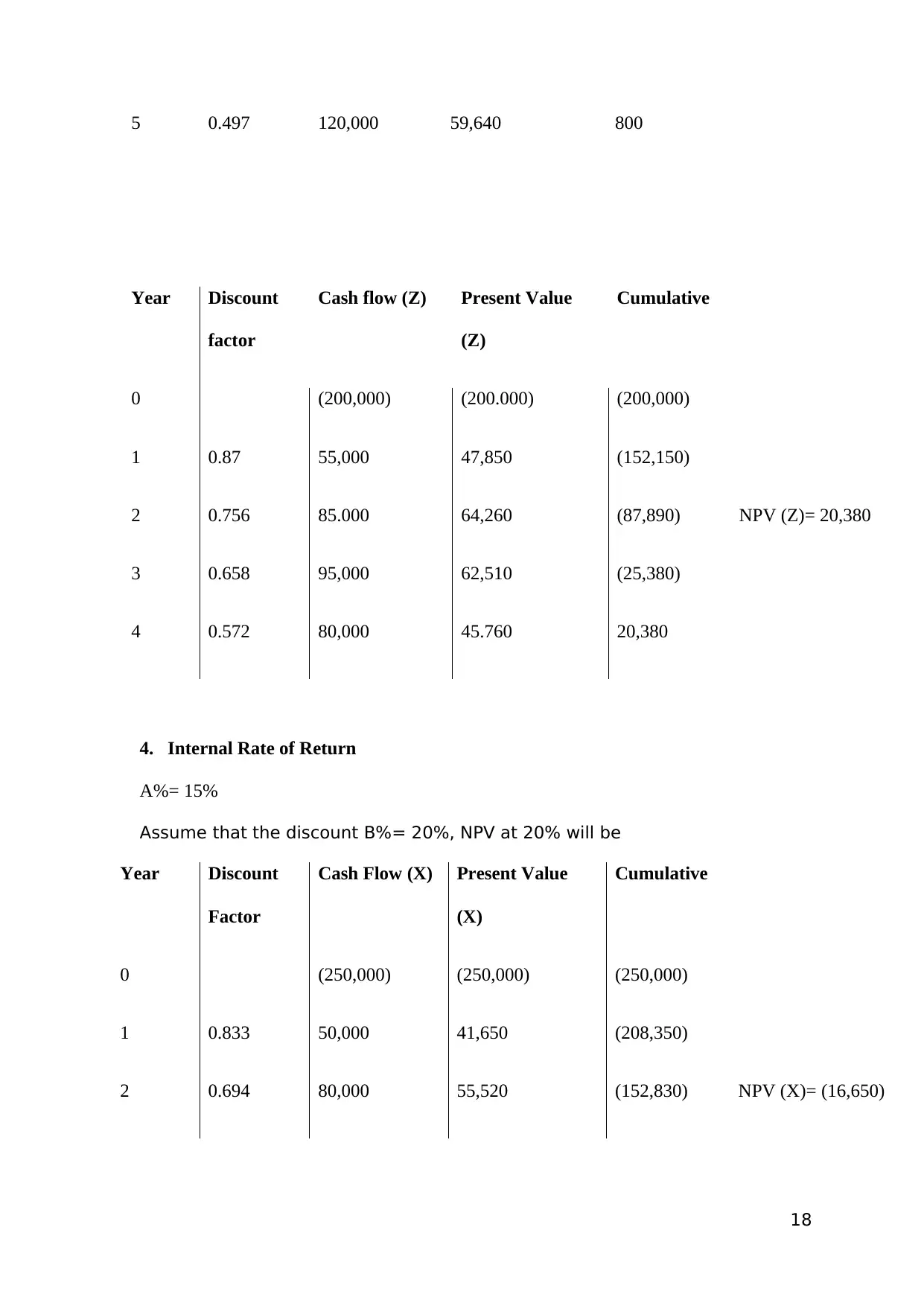
Year Discount
factor
Cash flow (Z) Present Value
(Z)
Cumulative
0 (200,000) (200.000) (200,000)
1 0.87 55,000 47,850 (152,150)
2 0.756 85.000 64,260 (87,890) NPV (Z)= 20,380
3 0.658 95,000 62,510 (25,380)
4 0.572 80,000 45.760 20,380
4. Internal Rate of Return
A%= 15%
Assume that the discount B%= 20%, NPV at 20% will be
Year Discount
Factor
Cash Flow (X) Present Value
(X)
Cumulative
0 (250,000) (250,000) (250,000)
1 0.833 50,000 41,650 (208,350)
2 0.694 80,000 55,520 (152,830) NPV (X)= (16,650)
18
⊘ This is a preview!⊘
Do you want full access?
Subscribe today to unlock all pages.

Trusted by 1+ million students worldwide

4 0.482 80,000 38,560 (44,790)
5 0.402 70,000 28,140 (16,650)
IRR (X) = 15%+ (NPV (15%)/ (NPV (15%)-NPV (20%))*(20%-15%)
= 15% + (13,490/(13,490-(-16650)) * (20%-15%)
= 0.226
Year Discount
Factor
Cash Flow (Y) Present Value (Y) Cumulative
0 (280,000) (280,000) (280,000)
1 0.833 100,000 83,300 (196,700)
2 0.694 70,000 48,580 (148,120)
3 0.579 80,000 46,320 (101,800)
4 0.482 50,000 24 (77,700)
5 0.402 120,000 48,240 (29,460)
IRR (Y) = 15%+ (NPV (15%)/ (NPV (15%)-NPV (20%))*(20%-15%)
= 15% + (800/ (800-(-2946))* (20%-15%)
= 0.154
Year Discount
Factor
Cash Flow (Y) Present Value (Y) Cumulative
19
Paraphrase This Document
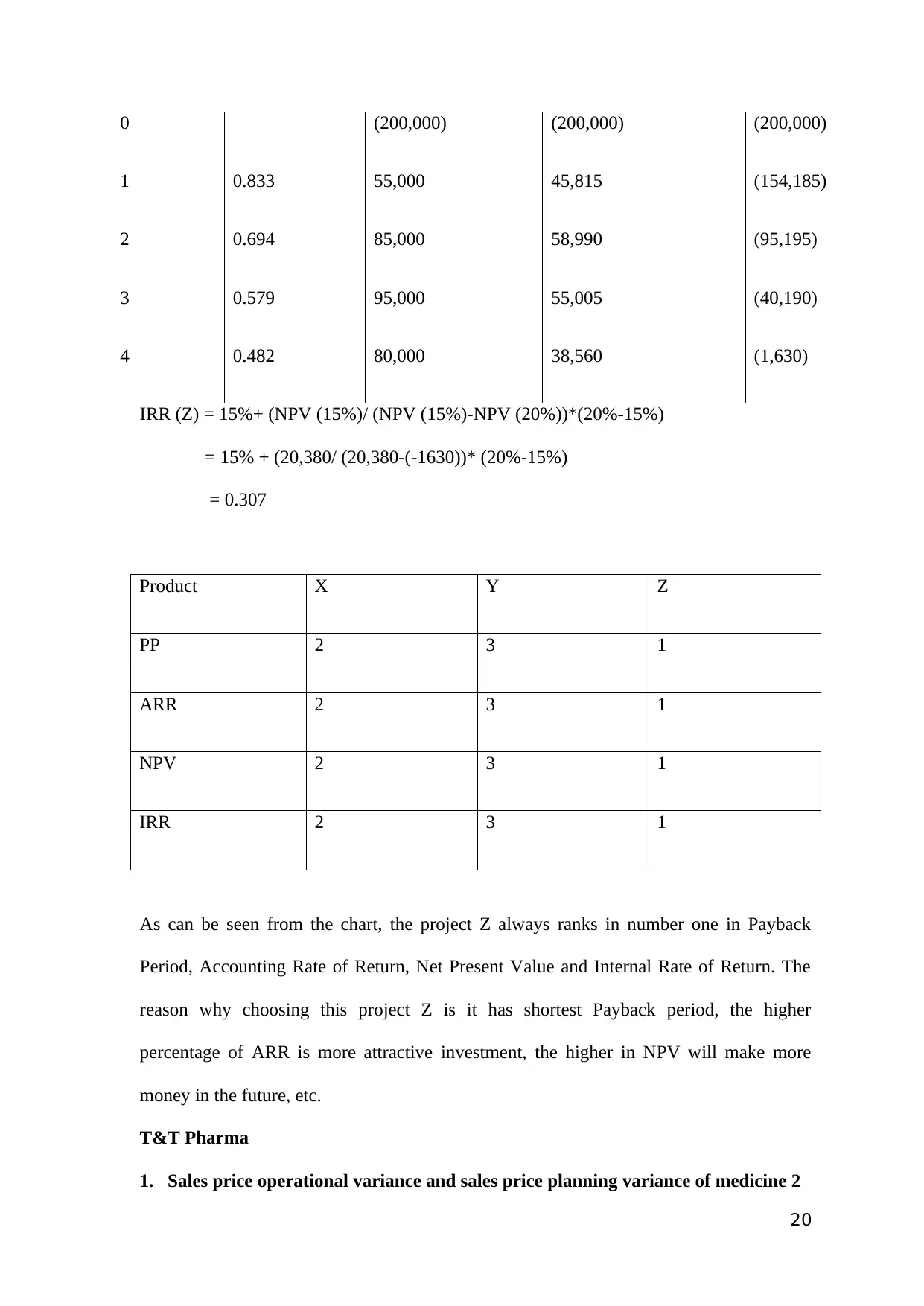
1 0.833 55,000 45,815 (154,185)
2 0.694 85,000 58,990 (95,195)
3 0.579 95,000 55,005 (40,190)
4 0.482 80,000 38,560 (1,630)
IRR (Z) = 15%+ (NPV (15%)/ (NPV (15%)-NPV (20%))*(20%-15%)
= 15% + (20,380/ (20,380-(-1630))* (20%-15%)
= 0.307
Product X Y Z
PP 2 3 1
ARR 2 3 1
NPV 2 3 1
IRR 2 3 1
As can be seen from the chart, the project Z always ranks in number one in Payback
Period, Accounting Rate of Return, Net Present Value and Internal Rate of Return. The
reason why choosing this project Z is it has shortest Payback period, the higher
percentage of ARR is more attractive investment, the higher in NPV will make more
money in the future, etc.
T&T Pharma
1. Sales price operational variance and sales price planning variance of medicine 2
20
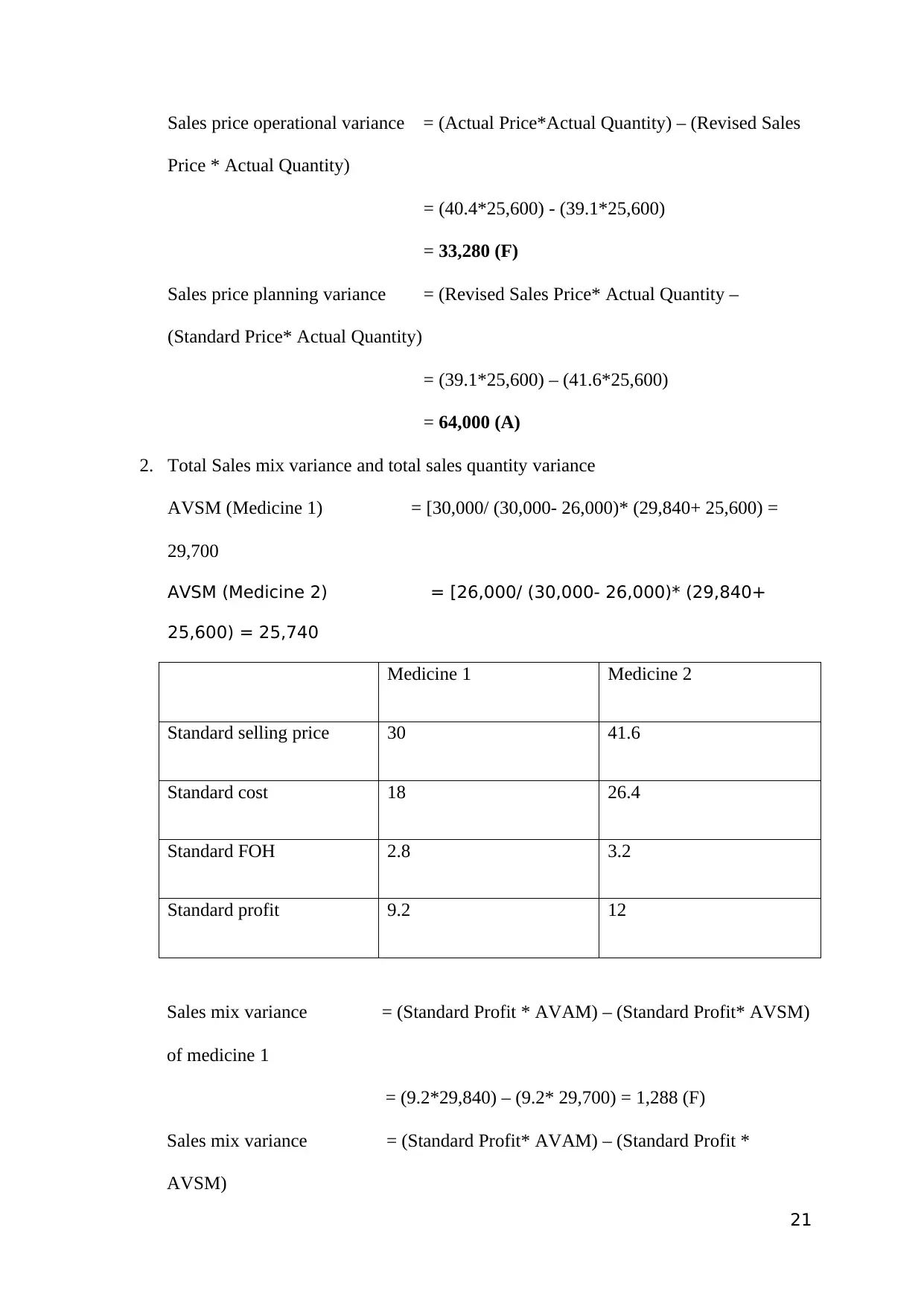
Price * Actual Quantity)
= (40.4*25,600) - (39.1*25,600)
= 33,280 (F)
Sales price planning variance = (Revised Sales Price* Actual Quantity –
(Standard Price* Actual Quantity)
= (39.1*25,600) – (41.6*25,600)
= 64,000 (A)
2. Total Sales mix variance and total sales quantity variance
AVSM (Medicine 1) = [30,000/ (30,000- 26,000)* (29,840+ 25,600) =
29,700
AVSM (Medicine 2) = [26,000/ (30,000- 26,000)* (29,840+
25,600) = 25,740
Medicine 1 Medicine 2
Standard selling price 30 41.6
Standard cost 18 26.4
Standard FOH 2.8 3.2
Standard profit 9.2 12
Sales mix variance = (Standard Profit * AVAM) – (Standard Profit* AVSM)
of medicine 1
= (9.2*29,840) – (9.2* 29,700) = 1,288 (F)
Sales mix variance = (Standard Profit* AVAM) – (Standard Profit *
AVSM)
21
⊘ This is a preview!⊘
Do you want full access?
Subscribe today to unlock all pages.

Trusted by 1+ million students worldwide
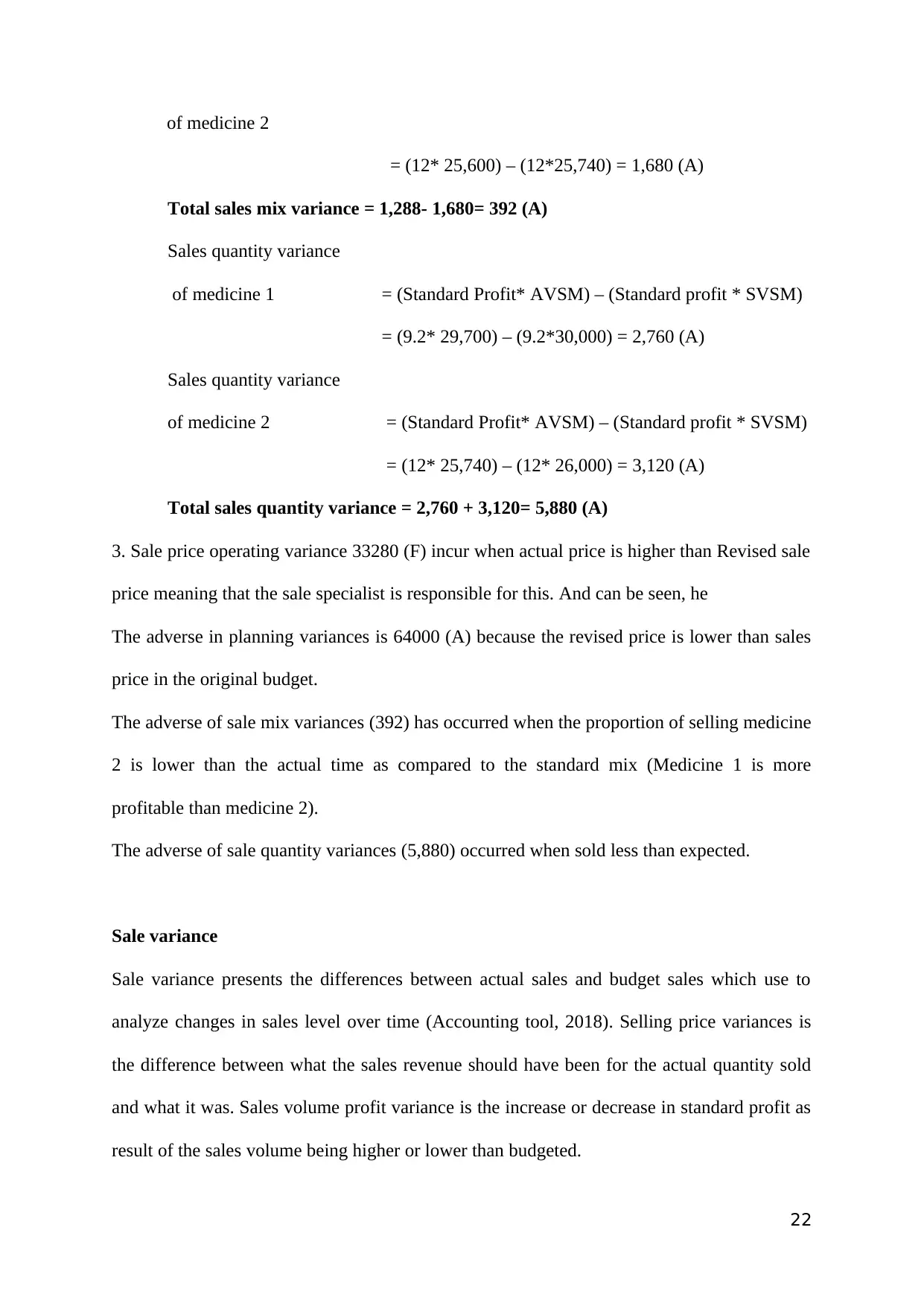
= (12* 25,600) – (12*25,740) = 1,680 (A)
Total sales mix variance = 1,288- 1,680= 392 (A)
Sales quantity variance
of medicine 1 = (Standard Profit* AVSM) – (Standard profit * SVSM)
= (9.2* 29,700) – (9.2*30,000) = 2,760 (A)
Sales quantity variance
of medicine 2 = (Standard Profit* AVSM) – (Standard profit * SVSM)
= (12* 25,740) – (12* 26,000) = 3,120 (A)
Total sales quantity variance = 2,760 + 3,120= 5,880 (A)
3. Sale price operating variance 33280 (F) incur when actual price is higher than Revised sale
price meaning that the sale specialist is responsible for this. And can be seen, he
The adverse in planning variances is 64000 (A) because the revised price is lower than sales
price in the original budget.
The adverse of sale mix variances (392) has occurred when the proportion of selling medicine
2 is lower than the actual time as compared to the standard mix (Medicine 1 is more
profitable than medicine 2).
The adverse of sale quantity variances (5,880) occurred when sold less than expected.
Sale variance
Sale variance presents the differences between actual sales and budget sales which use to
analyze changes in sales level over time (Accounting tool, 2018). Selling price variances is
the difference between what the sales revenue should have been for the actual quantity sold
and what it was. Sales volume profit variance is the increase or decrease in standard profit as
result of the sales volume being higher or lower than budgeted.
22
Paraphrase This Document
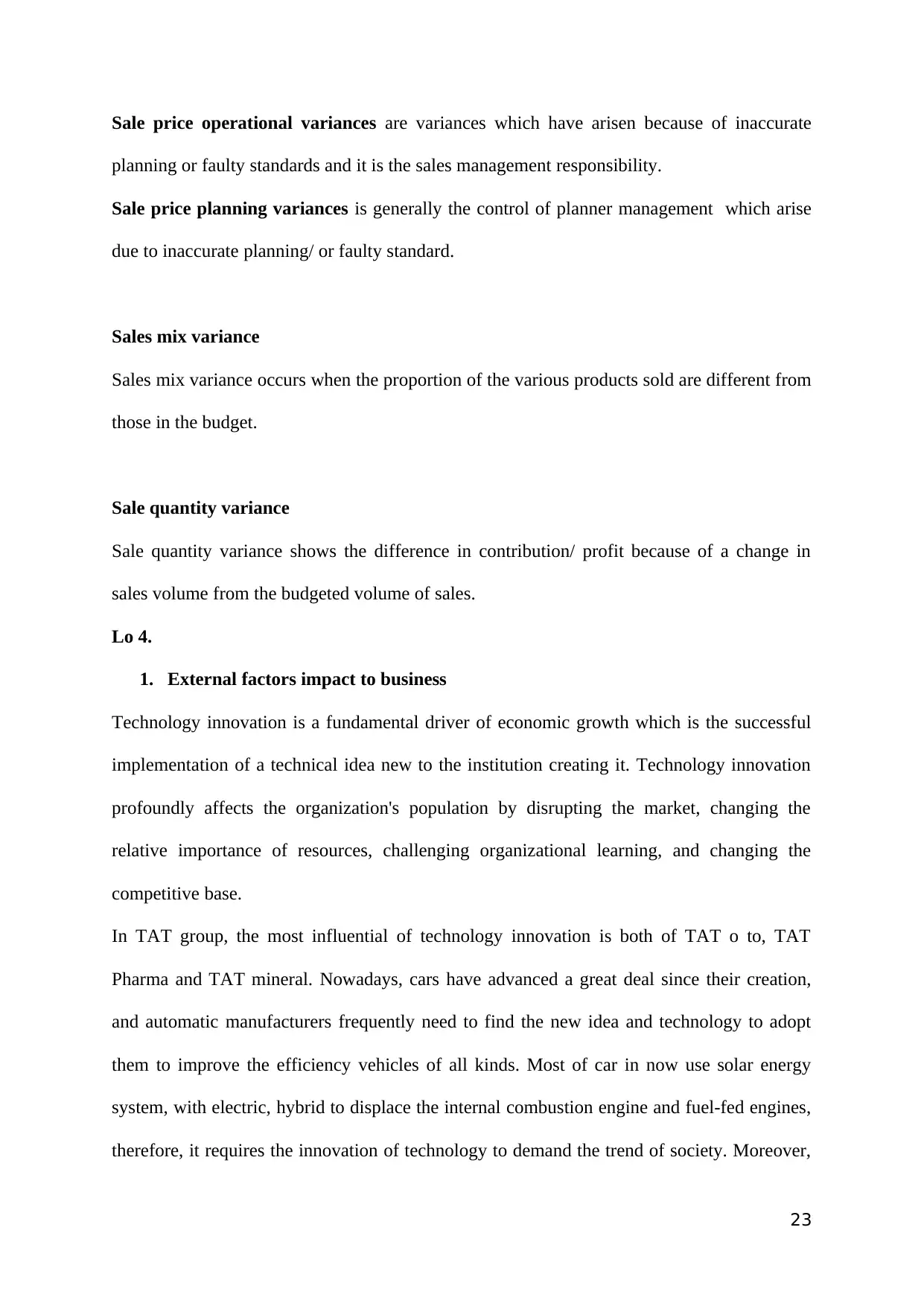
planning or faulty standards and it is the sales management responsibility.
Sale price planning variances is generally the control of planner management which arise
due to inaccurate planning/ or faulty standard.
Sales mix variance
Sales mix variance occurs when the proportion of the various products sold are different from
those in the budget.
Sale quantity variance
Sale quantity variance shows the difference in contribution/ profit because of a change in
sales volume from the budgeted volume of sales.
Lo 4.
1. External factors impact to business
Technology innovation is a fundamental driver of economic growth which is the successful
implementation of a technical idea new to the institution creating it. Technology innovation
profoundly affects the organization's population by disrupting the market, changing the
relative importance of resources, challenging organizational learning, and changing the
competitive base.
In TAT group, the most influential of technology innovation is both of TAT o to, TAT
Pharma and TAT mineral. Nowadays, cars have advanced a great deal since their creation,
and automatic manufacturers frequently need to find the new idea and technology to adopt
them to improve the efficiency vehicles of all kinds. Most of car in now use solar energy
system, with electric, hybrid to displace the internal combustion engine and fuel-fed engines,
therefore, it requires the innovation of technology to demand the trend of society. Moreover,
23
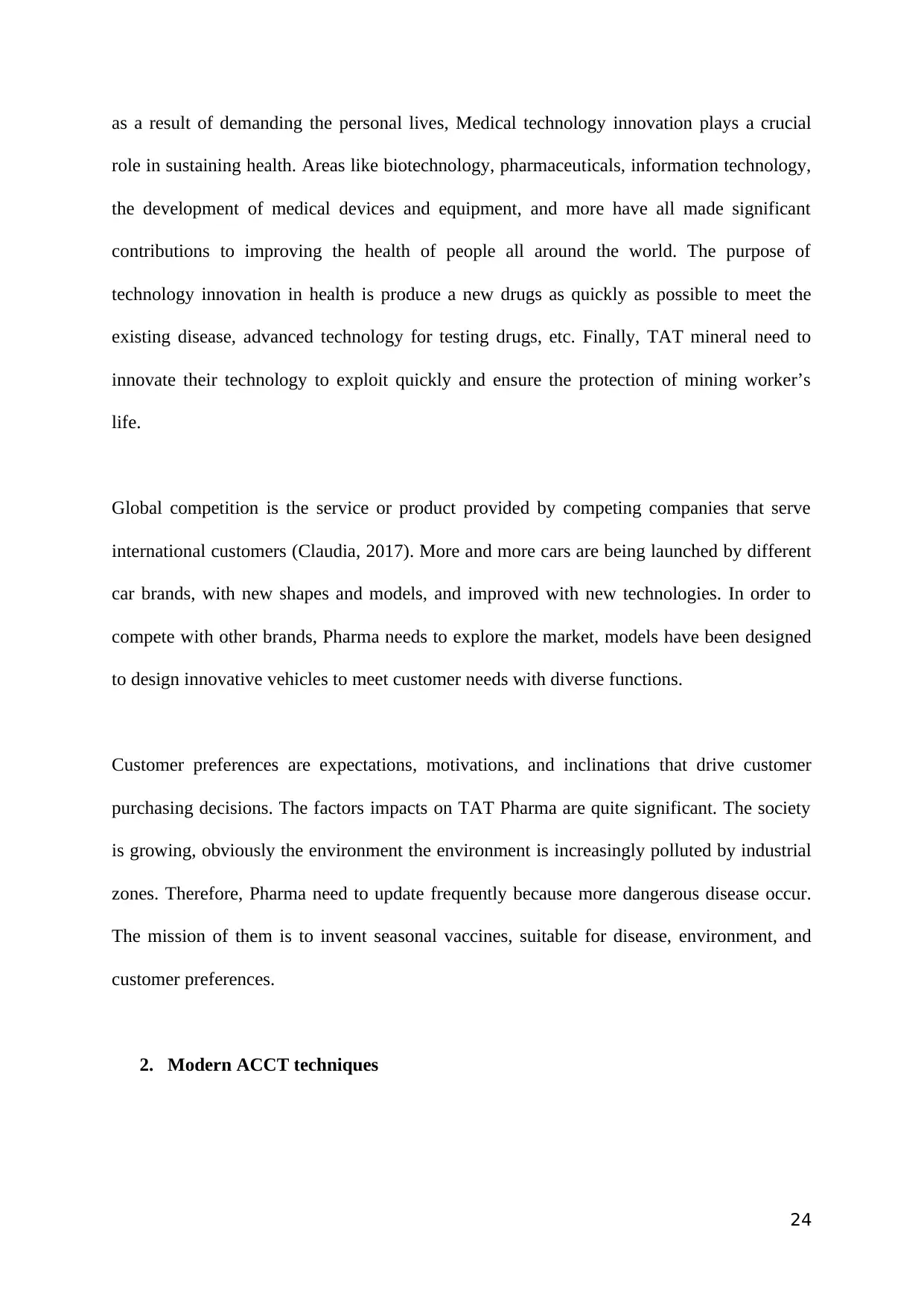
role in sustaining health. Areas like biotechnology, pharmaceuticals, information technology,
the development of medical devices and equipment, and more have all made significant
contributions to improving the health of people all around the world. The purpose of
technology innovation in health is produce a new drugs as quickly as possible to meet the
existing disease, advanced technology for testing drugs, etc. Finally, TAT mineral need to
innovate their technology to exploit quickly and ensure the protection of mining worker’s
life.
Global competition is the service or product provided by competing companies that serve
international customers (Claudia, 2017). More and more cars are being launched by different
car brands, with new shapes and models, and improved with new technologies. In order to
compete with other brands, Pharma needs to explore the market, models have been designed
to design innovative vehicles to meet customer needs with diverse functions.
Customer preferences are expectations, motivations, and inclinations that drive customer
purchasing decisions. The factors impacts on TAT Pharma are quite significant. The society
is growing, obviously the environment the environment is increasingly polluted by industrial
zones. Therefore, Pharma need to update frequently because more dangerous disease occur.
The mission of them is to invent seasonal vaccines, suitable for disease, environment, and
customer preferences.
2. Modern ACCT techniques
24
⊘ This is a preview!⊘
Do you want full access?
Subscribe today to unlock all pages.

Trusted by 1+ million students worldwide
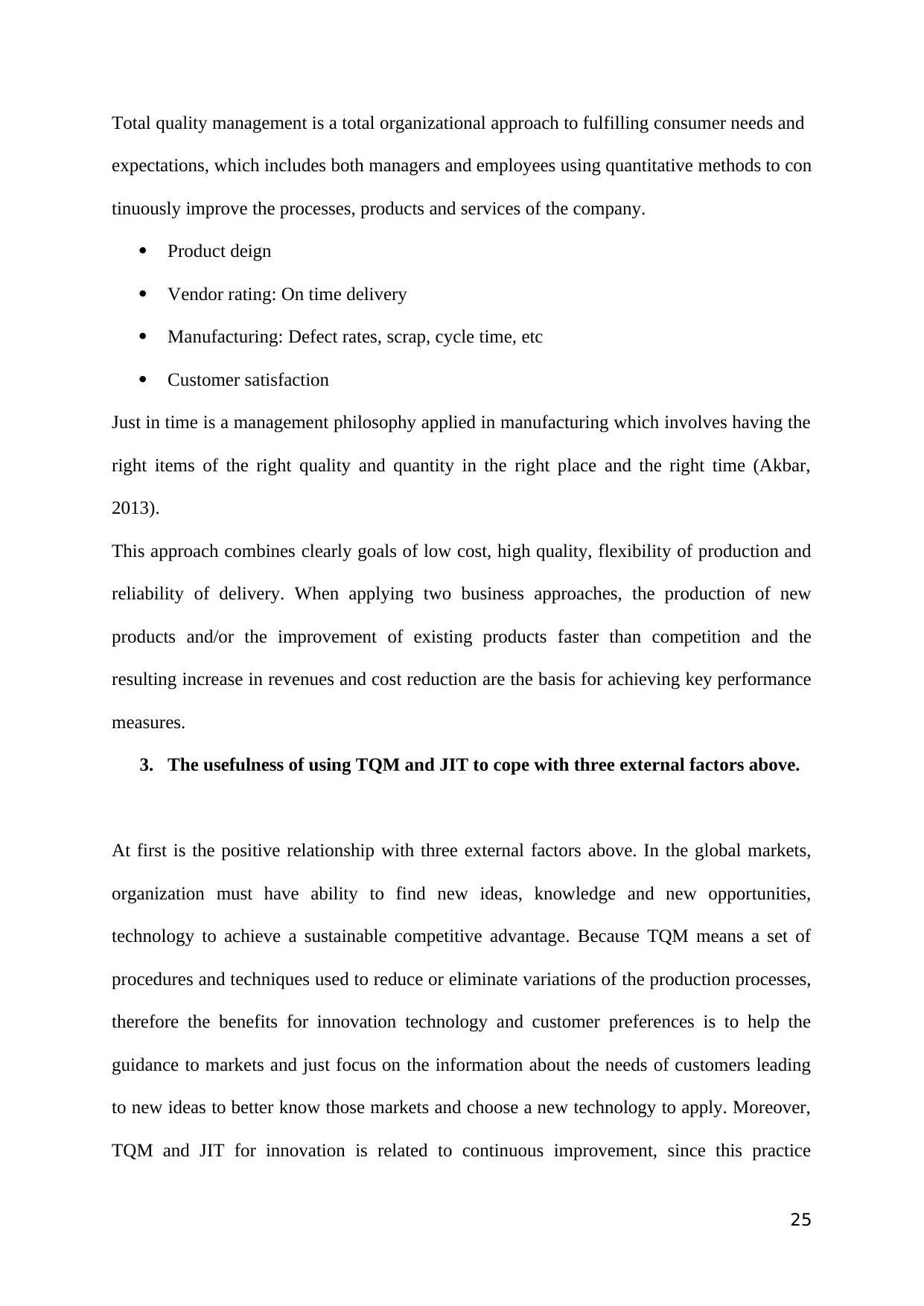
expectations, which includes both managers and employees using quantitative methods to con
tinuously improve the processes, products and services of the company.
Product deign
Vendor rating: On time delivery
Manufacturing: Defect rates, scrap, cycle time, etc
Customer satisfaction
Just in time is a management philosophy applied in manufacturing which involves having the
right items of the right quality and quantity in the right place and the right time (Akbar,
2013).
This approach combines clearly goals of low cost, high quality, flexibility of production and
reliability of delivery. When applying two business approaches, the production of new
products and/or the improvement of existing products faster than competition and the
resulting increase in revenues and cost reduction are the basis for achieving key performance
measures.
3. The usefulness of using TQM and JIT to cope with three external factors above.
At first is the positive relationship with three external factors above. In the global markets,
organization must have ability to find new ideas, knowledge and new opportunities,
technology to achieve a sustainable competitive advantage. Because TQM means a set of
procedures and techniques used to reduce or eliminate variations of the production processes,
therefore the benefits for innovation technology and customer preferences is to help the
guidance to markets and just focus on the information about the needs of customers leading
to new ideas to better know those markets and choose a new technology to apply. Moreover,
TQM and JIT for innovation is related to continuous improvement, since this practice
25
Related Documents
Your All-in-One AI-Powered Toolkit for Academic Success.
+13062052269
info@desklib.com
Available 24*7 on WhatsApp / Email
![[object Object]](/_next/static/media/star-bottom.7253800d.svg)
© 2024 | Zucol Services PVT LTD | All rights reserved.





